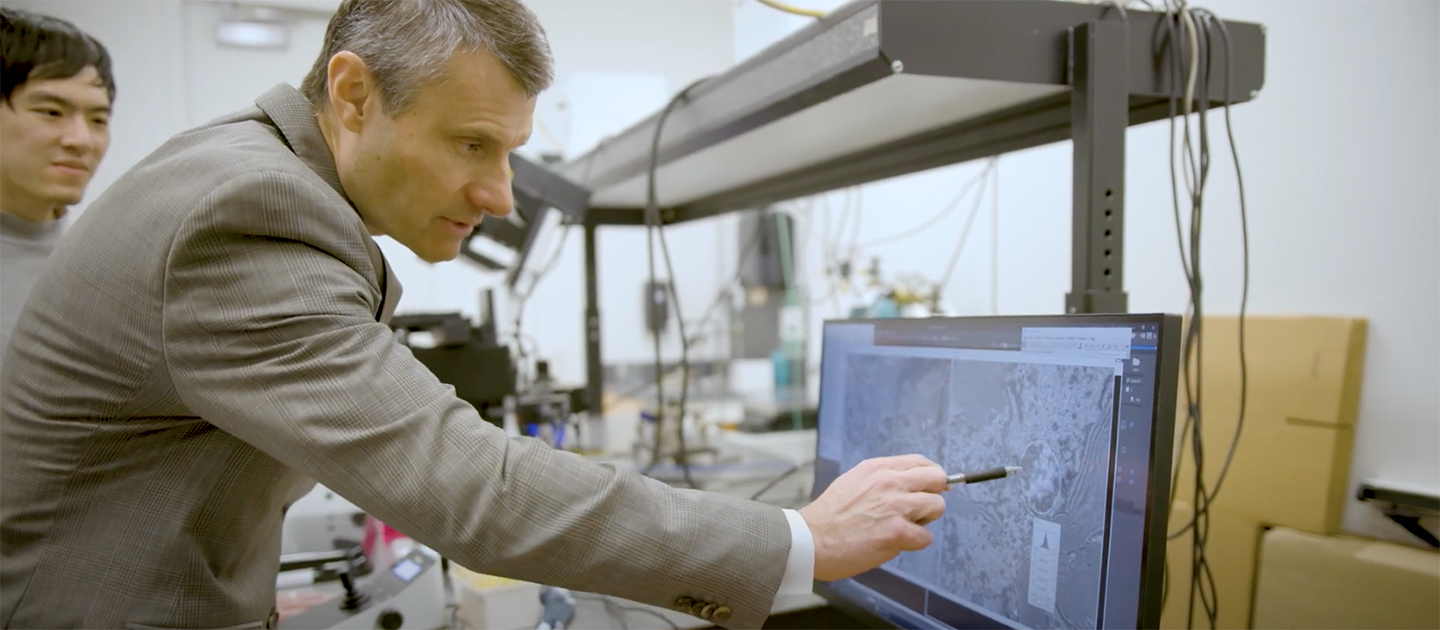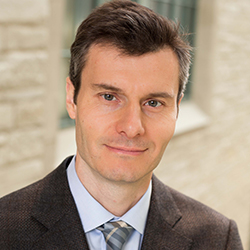How a Cheek Swab Could Help Fight Lung Cancer
The novel test developed detects chromatin alterations, changes that are associated with the earliest stages of carcinogenesis and cancer progression.
 Research
Research
Innovative research. Multiple training programs. An annual symposium.
Since its launch in 2019, Northwestern Engineering’s Center for Physical Genomics and Engineering (CPGE) has made a notable impact on the growing field of physical genomics.

Under the leadership of Northwestern Engineering’s Vadim Backman, CPGE continues to expand its efforts to study methods to manipulate chromatin structure, which regulates gene expression, in order to treat disease and engineer living systems to overcome environmental challenges.
“The time is right to scale up what we do, which really means more funding and more collaborations,” said Backman, Sachs Family Professor of Biomedical Engineering and Medicine at the McCormick School of Engineering and the Northwestern Feinberg School of Medicine and CPGE director. “Northwestern is one of the very few places in the world where this kind of research can be conducted.”
Physical genomics is a field that involves understanding the structure, function, and fundamental physical principles of the genome. With this understanding, researchers can develop and apply engineering techniques to develop ways to reversibly regulate, control, and even reprogram global patterns of gene expression. The goal is to be able to impact biological outcomes without altering an organism’s genes themselves.
The center develops new nanoscale imaging tools, modeling and computational technologies that have the potential to open new fields of biological research, lead to new strategies for treatment of disease, and enable adaptive engineering of plants and animals to meet environmental challenges or even to regenerate tissues.
“The overall goal of physical genomics is to understand the physical principles that regulate gene expression,” said Luisa Marcelino, a research assistant professor of civil and environmental engineering at CPGE.
One major focus of CPGE is cancer research. CPGE is part of two NIH-funded national research networks: the National Cancer Institute (NCI) Cellular Cancer Biology Imaging Research network develops and tests new nanoimaging technologies, used in combination with molecular and computational methods, to study the origin of cancer stem cells and their ability to adapt to chemotherapies. As part of this network, the Northwestern University Center for Chromatin Nanoimaging in Cancer brings together researchers in optics, imaging analysis, electron microscopy, computational genomics, and cancer biology to address knowledge and technology gaps that could help to develop therapeutic strategies that prevent the development of tumor resistance to therapeutics – a crucial and often intractable issue in cancer treatment.
Then there is the National Cancer Institute (NCI) Metastasis Research Network, in which CPGE participates in collaboration with MIT and Dana Farber Cancer Institute on a project titled “Mechanical Determinants of Organ-Selective Metastatic Colonization, Dormancy and Outgrowth”, which seeks to understand the processes underlying tumor cell fate and to enhance the ability to develop new therapies that can inhibit the spread of metastatic disease.
The novel test developed detects chromatin alterations, changes that are associated with the earliest stages of carcinogenesis and cancer progression.
A concept was demonstrated that showed implants which had micropillar surfaces had more bone formed than defects which received implants with a flat surface.
The event featured talks by five world-renowned scientists who explored the latest research in genome structure and dynamics, imaging and engineering, and more.
Through these projects, the ability to manipulate cells at the fundamental level of genomic programming may lead to the development of a principally new, physics-based anti-cancer strategy that could prevent the emergence of tumor cell resistance to anti-cancer therapies and slow or even prevent metastasis. Preventing chemoresistance would overcome the primary cause of treatment failure in many cancer patients.
“Most patients don’t die because of the primary tumor. Most patients die because of metastasis,” Backman said. “The question is: can we affect cancer-cell reprogramming in such a way that metastatic cells do not survive?”
In addition to its annual symposium and monthly seminar series, which brings together internationally renowned leaders in the field, and its publicly available archive of video lectures, the center maintains multiple training programs to support the next generation of researchers. The Physical Genomics Training Program, supported by a T32 grant from the National Institutes of Health, provides tuition and financial support for predoctoral projects that bridge molecular biology, bioengineering, physics, optics, chemistry, and medicine and promotes joint research between the McCormick School of Engineering and other University schools.
The NSF-supported CPGE Research Experience and Mentoring (REM) Program cultivates a diverse and inclusive scientific workforce through a six-week, hands-on research experience for undergraduate students who may not otherwise become engaged in scientific research.
“What I enjoy most is interacting with students and seeing them progress through their projects and making new discoveries,” said Jayms Peterson, the center’s senior director of operations and outreach.
The importance of CPGE’s work and potential impact on society cannot be overstated.
“The Center for Physical Genomics and Engineering is involved in developing technologies that will have the potential to address some of the most critical challenges facing the world in the 21st century,” Backman said.